This was great. In the Almea+400 project I said that the reason the ktuvoks could rule for 4000 years was the quality of the fish sauce, but now I have to add the music. Submission to undersea monster gods has never sounded so good.sasasha wrote: ↑Tue Jan 16, 2024 10:10 am So... this was exploratory, and fun. As this text is not actually attested in-world in Munkhâshi, the only way I can really use it is if there is a group of Gelalhát purists who re-construct Munkhâshi and try to conduct 'authentic' ancient rituals. Or as the opening of a metal concert, or something...
Dhekhnam: Ktuti bikoshil
Almeomusica
-
zompist
- Site Admin
- Posts: 2944
- Joined: Sun Jul 08, 2018 5:46 am
- Location: Right here, probably
- Contact:
Re: Neo-Munkhâshi chant
Re: Neo-Munkhâshi chant
Really glad you enjoyed it so much!zompist wrote: ↑Tue Jan 16, 2024 10:27 pmThis was great. In the Almea+400 project I said that the reason the ktuvoks could rule for 4000 years was the quality of the fish sauce, but now I have to add the music. Submission to undersea monster gods has never sounded so good.sasasha wrote: ↑Tue Jan 16, 2024 10:10 am So... this was exploratory, and fun. As this text is not actually attested in-world in Munkhâshi, the only way I can really use it is if there is a group of Gelalhát purists who re-construct Munkhâshi and try to conduct 'authentic' ancient rituals. Or as the opening of a metal concert, or something...
Dhekhnam: Ktuti bikoshil
Before I made it, but after the inspiration had struck, I made myself the most Dhekhnami-seeming lunch I could muster. I fried up leftovers – cabbage and mashed potato ‒ in lashings of fish sauce, and added in a few crushed Sichuan peppercorns, some turmeric powder and a bit of soy sauce. I was lacking pig fat, but it still tasted pretty têç.
Re: Almeomusica
Good question, and my instinct says no, and that there'd be no reason to try to optimise the design so much so early in its history. Most of us still use a keyboard (of letters) which was designed so the word ‘typewriter’ can be found on the top row to make it easier for salespeople to demonstrate, despite hundreds of suggestions for improvement.
It's also worth saying ‒ there were no pianos in 1591, and the keyboard I've drawn isn't quite for a piano either, strictly speaking. As you've translated teclora as ‘clavier’, ‘keyboard’ and ‘piano’, I've taken a broader approach. I think the instrument I've drawn is probably more like a clavichord, where strings are struck upwards by a tangent, leaving the key mechanism very simple (i.e. it's just a lever). Hammer action, weighted keys, and something more resembling our piano can certainly exist in 3480 and can come to prominence before long ‒ but I feel in 3480 these instruments would be on the rare side and still in development/relatively recently ‘just invented’; as with our word ‘clavier’, ‘teclora’ is probably a general term for stringed keyboard instruments until people are so used to a standard set of different types of them that they start to use more specific terms further down the line.
Though do shout if you saw this development differently / want 3480 Verdurians to have sophisticated pianos! (It might be nice to give Kainan surcont Solhai a cameo here, somewhere.)
Quite ‒ this was one of the design principles. And yes, in the right hand, a fifth is easy to play that way ‒ in the left, it will be common I think to put down a fifth with little finger (5) and ring finger (4), and play riffs above with fingers 3, 2 and 1.One thing I like about sasasha's design is that it wouldn't disfavor smaller hands. It's also interesting that, if I'm not mistaken, a fifth is always just above the tonic. Unless he takes my suggestion to offset the keyboards! In fact that might make a fifth easier to play (presumably with thumb and index finger).
This is essentially why I wanted a third manual: if you are playing something in a key that lives on the top row, I want you to be able to play the same patterns as you learn for the bottom row, necessitating a third row above reduplicating the first row exactly. I thought it was practically impossible to construct, but now I think not. I'll try it... the keys will shrink, lengthways, I think. We'll see!bradrn wrote: ↑Tue Jan 16, 2024 7:05 pm Incidentally, this is also the case with the Wicki layout, another isomorphic keyboard used for concertinas.
Dëkuy! So glad you like it!
Re: Almeomusica
Sorry, but I can't do throat singing. Or much of any kind of singing, really. And I'm afraid I don't even know all that much about music, except that I like a lot of it.sasasha wrote: ↑Tue Jan 16, 2024 5:06 pmAh, I see!! If I could do throat singing, I would absolutely have put it on.
The idea really is that this is a group ritual, but only one person has to know the chant and solo it out. Everyone else present can join in ‒ they sing a drone, or a gentle ululation, or lhhhhh noises, or something ‒ they contribute to the sound however they want, just being sure not to overpower the chant. If they can do throat singing (and I bet they often can) then they would probably do that.
I might rebalance this so more of the background is audible: there is actually one voice trying to sing harmonics à la throat singers, one voice growling low notes, one voice doing an odd growling trumpet thing (it's a uvular trill inside a hum), and various other textures. (Try headphones.)
If by any chance you can throat sing, it would be amazing to incorporate that!! Or if you want to join the faithful of Gelalh and add your voice/sound in any way. Just send me a track and I'll mix it in.mp3 is fine.
Re: Almeomusica
Not what I expected as well - this reminds me a lot of what I've heard of Orthodox Church singing. Sounds great!Dhekhnam: Ktuti bikoshil
Re: Almeomusica
Thanks! Yeah, that's a good reference point. What did you expect to hear, out of interest, and what surprised you? I'd like to make more Dhekhnami pieces, so I'd love to hear.
For me, one thing I didn't want to do was make this sound overly ‘evil empire’-ish. From what I've read, the Dhekhnami are generally quite happy to be Dhekhnami, and they seem (from the grammars) to love singing and dancing. Ok, their aesthetics is different, they think reptiles and creepy crawlies are beautiful and mammalian comforts are weak ‒ but they still have pleasures. I want their music to reflect that, whilst still seeming different.
No problem! I feel that way about a bunch of things ‒ maths, for instance. Love to watch others do it...!
Re: Almeomusica
I'm getting a bit of topic now, but I think what you describe is generally a much better attitude than to think "I'm not good at this, therefore it is worthless."
-
zompist
- Site Admin
- Posts: 2944
- Joined: Sun Jul 08, 2018 5:46 am
- Location: Right here, probably
- Contact:
Re: Almeomusica
All good points; one of the things I liked about your piece was precisely was that it doesn't sound like what a film composer would do with Mordor.sasasha wrote: ↑Wed Jan 17, 2024 1:50 pm For me, one thing I didn't want to do was make this sound overly ‘evil empire’-ish. From what I've read, the Dhekhnami are generally quite happy to be Dhekhnami, and they seem (from the grammars) to love singing and dancing. Ok, their aesthetics is different, they think reptiles and creepy crawlies are beautiful and mammalian comforts are weak ‒ but they still have pleasures. I want their music to reflect that, whilst still seeming different.
The ktuvok empires shouldn't be over-romanticized... at the least, the social structures are extremely hierarchical, so it's probably much like going to a British public school. And it's worse if you're not Demoshi or Carhinno. Still, a case can be made that during the Dark Years at least, it was better to be a Dhekhnami than an Eretaldan peasant. Few wars, no roving bandits, no nomads, and a ruling class that didn't really need and thus didn't extract all the wealth created by humans.
Re: Almeomusica
Yeah, well, the evil empire vibe was what I was expecting, or maybe something going into the Heavy Metal direction. But I get your and zompist's points. Reminds me of Douglas Adams's genocidal Krikkits, who sing the most beautiful songs in the universe.sasasha wrote: ↑Wed Jan 17, 2024 1:50 pm Thanks! Yeah, that's a good reference point. What did you expect to hear, out of interest, and what surprised you? I'd like to make more Dhekhnami pieces, so I'd love to hear.
For me, one thing I didn't want to do was make this sound overly ‘evil empire’-ish.
Meet the Žambeys
Subproject index
Episode 6: tireless hands and perfect arms
Diary of Kaidan Žambey
18 reli 3422 (calten)
Day 4: Trežda to Šerian
Sometimes change trickles; other times it takes hold of an organism whole and shakes it all at once into a new mode of being. So it was with the Sariley and her strange human cargo on the gentle calten morning in which we passed out of the southern countries and into Verdúria.
First, the sun came out, finally banishing the unseasonable chilly fog that has plagued us since Žésifo. Then, the colours arrived. Flowers on trees and riverbanks announced themselves to me, vivid and warm; whether none had been there in Krasnaya, or my mind had been too perturbed to see them, I cannot say. They studded the shining backdrop of the tall spring grass like gems on a velvet robe, which itself was matched and painted into the sky by the many Verdurian flags which heralded our transition into this land of extremes, waving like tireless hands.
The mood aboard began to chatter and buzz with the energy of leaving something old behind. It was the sound of a group remembering it could speak of plans and hopes, rather than wounds and woes. It even swept me up; I forgot, while the sun shone and the boat flew on, Como and my disgrace, my worries for Kutro and father, my near-dead career.
I burbled about where I might disembark and what I might do then with a sailor named Virny, who was spending an hour at rest catching the sun on top of the quarterdeck. We were joined by a mysterious young lady named Mëfa, who seems to be travelling alone, though under the protection of Gn. Sfica, and I’d wager anything was a post-noble runaway like me. Mëfa and I both said we were unsure about staying on all the way to Verdúria city; I joked that the chaos of Dobray had been quite enough for me, and said I fancied my chances to try for employment in Ulian or Vyat, where I would not be so far from home. (Of course, finding out Como's fate was foremost in my mind, which I kept to myself.)
But Virny said simply that Imdaluát and Cuéndimar in Verdúria were not to be missed – that he was going to stay the whole week in the city and return on the next boat – and stretched out his perfect arms in the sun to make a pillow for his head. We both changed our tune – cast, I think, under the same spell. Perhaps I will stay on, and learn to celebrate a king to whom I owe no fealty, with Virny’s Verdúria-style cool.
We stopped at noon at Tregör to pass customs. I remembered the border official from my journey up to see Elucöra: a cheeky old man with a pun for every occasion. He took my letter without incident, changed two of my nine remaining besimî, and quipped with me something about the restlessness of youth. (I will have to start earning money soon! My letter of credit should be saved for when I secure a post, so I might afford a few home comforts.)
I chose not, as the light drew in and we pulled into the faded splendour of Šerian, to remember the spot just beyond the docks, where I’d changed onto horseback in autumn for the remainder of the journey to Ulian – the spot where I’d seen, with a jolt, Como again, leading two horses, one to be his and one to be mine.
I disembarked again, and found a riotous inn at the edge of the sailors' district, underneath the steep Prosia Ataboë. I batted off notice of its unfortunate name: Soa Cumeliräma. Inside, I found a red-faced Kebreni singer with a little round guitar playing folk tunes. How he’d got there was anyone’s business. He was most interesting to speak to (in stilted Verdurian) about the way they teach music in Kebri. They call the notes, I found, by the same as our short names (en, vi, bo…) though they have a few different ones (en is actually e in Kebri). He said, if I understood him right, that the reason we call Ṃëranac ‘ma’ and not ‘mër’ is because it is taken from the Kebreni! He had a good bottle of wine on his table which he let me share, in return for a song. I did ‘So Šadec Gödoi’, which was fun, as he knew it, and he and a motley crowd that hazed around us joined in. He knew some rather funny words, and (with respect to him) they came out through a thick filter of drunken imprecision, which made it all the funnier.
Notes
calten - I worked out that the first day of Kaidan's journey, 15 reli 3422, was in fact a scúreden; I will go back and change the other entries, as it makes sense. The barge leaves Žésifo on scúreden, i.e. what essentially is Monday morning, and aims to get to Verdúria city by néronden (market day) 12 days later, resting overnight to maximise cargo space and avoid the risks of sailing in the dark.
post-noble - Kaidan’s sardonic Verdurian term is samelašte ‘through-noble’, modelled on sabelgom ‘veteran’ (lit. ‘through-war-person’). He may be referring to two factors here: firstly, his current disgrace, though he certainly hopes this is temporary. Secondly, his family’s noble title having been downgraded with the reassertion of Ctésifonian independence ‒ see the Prelude.
journey up to see Elucöra... changed onto horseback - Kaidan visited Ulian in the fall of 3421 to spend more time with his then-fiancée Elucöra Revouse and meet her family. (Como was Elucöra’s father’s stablehand.) That fall, Kaidan had travelled by ship from Žésifo to Šerian, though in a swifter vessel of a higher class. He then rode from Šerian to Ulian, cutting out a bend in the Svetla, guided by Como who had been sent to meet him. It had been a costlier, but significantly quicker journey; see Episode 1.
Imdaluát and Cuéndimar - Imdaluát is Coronation Day in Verduria, the second of King Vlaran; naturally Kaidan wouldn't be too knowledgeable about it, being from Ctésifon. Cuéndimar is the week-long Great Festival in honour of Enäron. In Vlaran's reign they fall in the same week.
customs - I don't know whether there would be a border official at customs in Tregör; it seems likely that this is the point of the settlement, which has nothing else published about it that I can find.
besimî... letter of credit - Kaidan has some coins sewn into his clothes; he also carries a letter of credit (in addition to his license letter allowing him to travel aboard) which he will be able to change at a temple for a larger sum of money.
faded splendour - Šerian (from Caď. ‘palace place’) was a winter retreat of the Caďinorian emperors, and contains some of the best-known Caďinorian ruins.
Prosia Atraboë - Emperors' Street
Soa Cumeliräma - The Fiancée (lit. ‘the one (f) to live with’)
little round guitar - probably a soprano čište of some kind; in 3422, for a Ctésifonian, these instruments are probably rare enough that Kaidan handwaves its actual name, at least when writing tired and a little drunk. However...
the way they teach music in Kebri - the episode highlights the growing interconnectedness of wider Eretald's musical culture: a Kebreni in Šerian knows a Muďucan folk song in broken Verdurian, and uses a musical language which, with some variations, is shared between the two cultural spheres.
en vi bo - shortenings of the note names presented in Episode 5. Some of the modern standard shortenings are indeed Kebreni in origin, and Kaidan actually uses the Kebreni variant of ve/vi without realising it, as it is in more or less free variation with its Verdurian counterpart across Eretald. As Kaidan learns, ma derives from Kebreni mardah́ rather than Verdurian Mëranac, and se, ke/ře and na similarly show Kebreni influence.
So Šadec Gödoi - a folk song from Muďuca, lit. ‘the rider/messenger of/from Gödo’. I don't have any words for it yet, but it is supposed to evoke thundering hooves as a messenger rushes from a neighbouring city ‒ my imagination says, perhaps with a pardon for an execution which is due at dawn.
The Eretaldan-Kebreni musical culture
The standard Caďinorian note names and visual representations thereof as capital letters with a lower dot (ẸṾC̣...) have been around for over a millennium (since the Aďivro), and they were synthesized into Kebreni by being given compatible Kebreni names around 2743, when Kebreni scholars set about combining Caďinorian law with native traditions. Thus a hybrid Kebreni-Eretaldan musical culture has been in existence, at least on some level, for around 750 years. (Though there is a great deal of local variation across this culture: they simply have the same shared base musical ‘language’.)
Here is a diagram of note names in Verdurian and Kebreni, with little pictures to show the meanings of the Kebreni long-form note names. (Apologies for a few misspellings, including ‘Osureon’ for ‘Oruseon’. Perhaps the drunken Kebreni did it.)
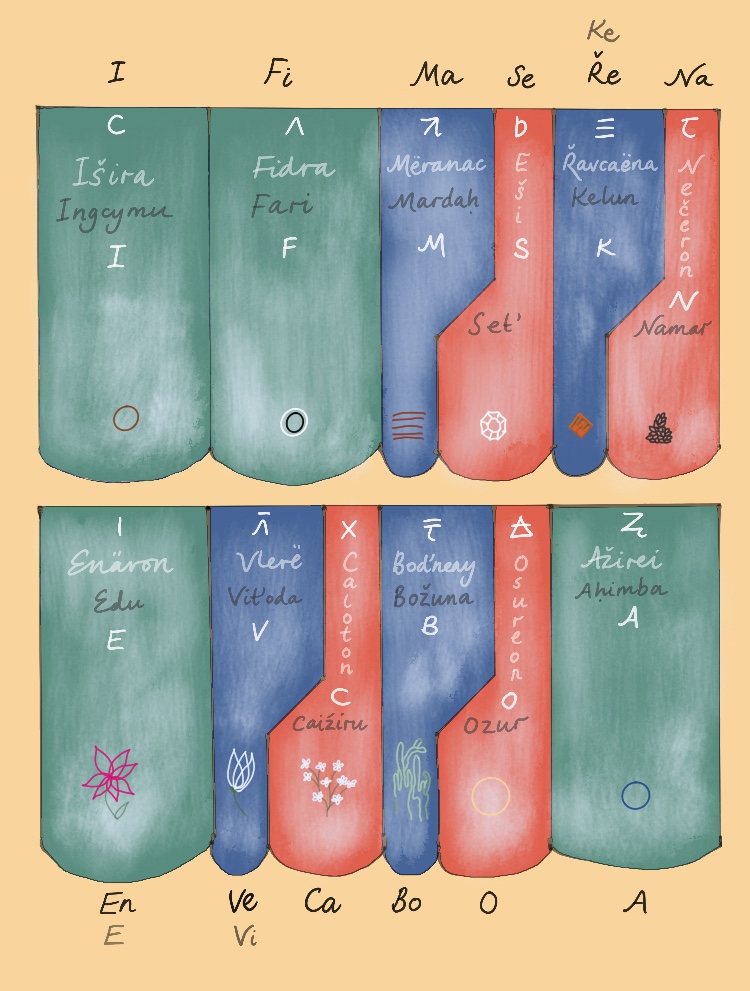
In the table below, the middle column shows the direction of borrowing. This was not a formal process, but organic, as musicians from Eretald proper and Kebri interacted, worked together, and shared notation. (It's probable that a lot of this synthesis happened in Érenat.)
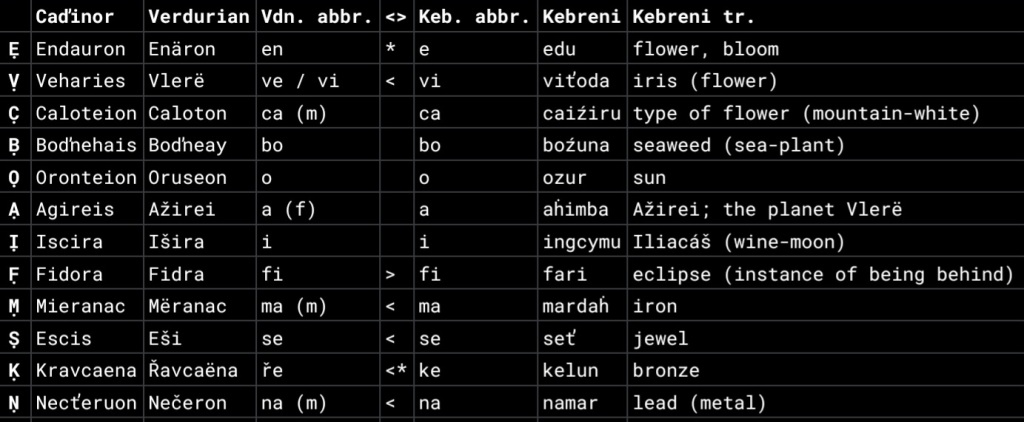
You can listen to me practicing ‘So Šadec Gödoi’ here, and below is a piece of tablature for its main theme, as might be familiar to (or written out by) both Kaidan Žambey and the Kebreni singer in 3422. I'll discuss notation another time; but this is a sneak peek.
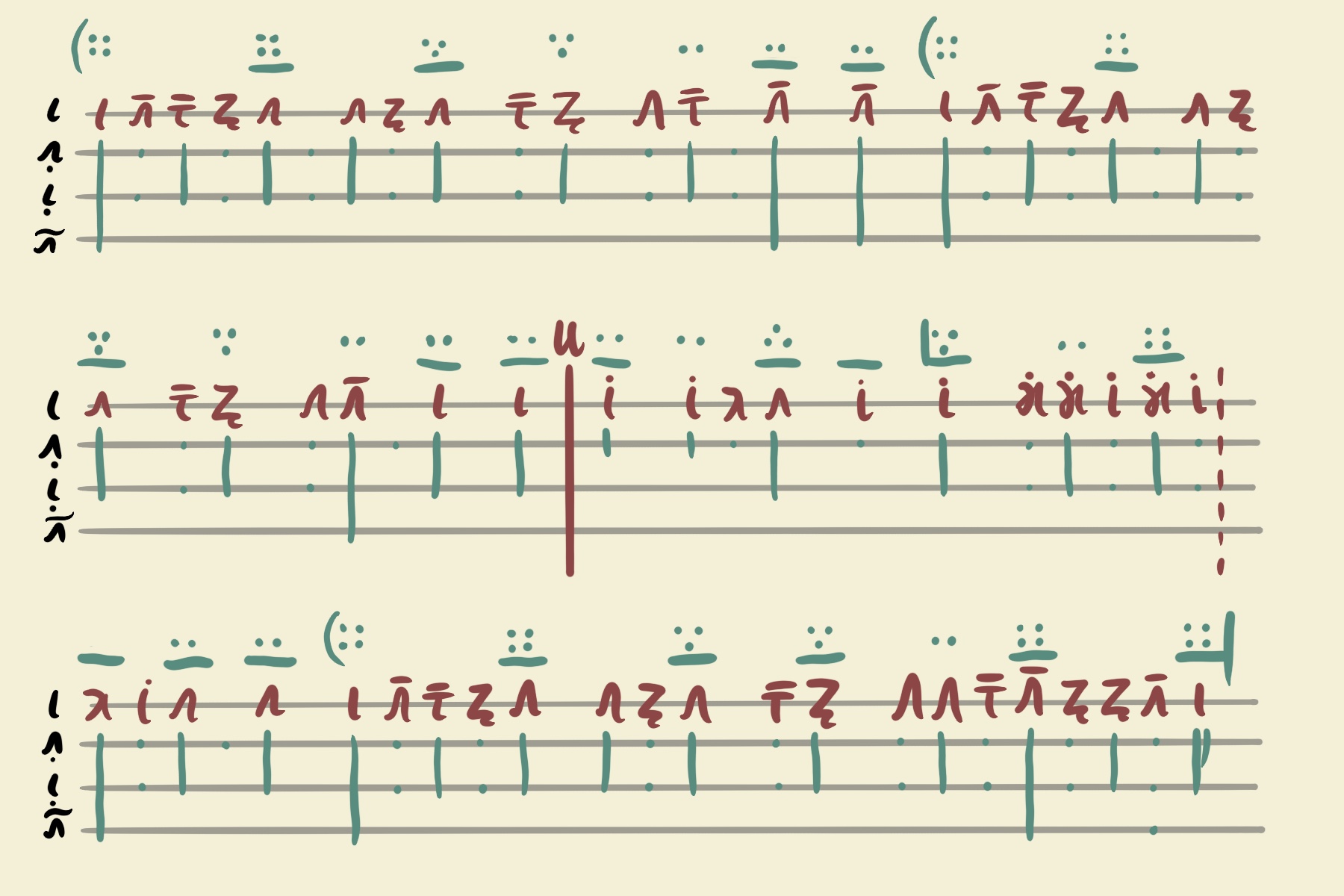
The scale which forms the main theme is the first of what are known in Ismahi as the ‘split tone modes’ (about which I will say more another time); these modes were associated with the eastern part of the Empire in late classical times, and (in the Aďivro) named after rivers in the region. In this classification the scale is the čimora Seree, or Serean scale; it contains the notes ẸṾḄẠF̣ṢṆ, and is colloquially known in Verduria as ‘evbafešne’.
We might call it the ‘Neapolitan major scale’, while in South India it is called Mela Kokilapriya, being the 11th numbered Melakarta ragam. However, in the higher second theme, the note C̣ appears instead of Ṿ, and Ṃ instead of Ṣ; we could say we've switched to the čimora Adelei or Aeolian mode, or instead evoke the trick of changing the notes in the scale/gamut which makes up the tune when entering a higher octave, which is commonly found in Japanese traditional music.
Episode 6: tireless hands and perfect arms
Diary of Kaidan Žambey
18 reli 3422 (calten)
Day 4: Trežda to Šerian
Sometimes change trickles; other times it takes hold of an organism whole and shakes it all at once into a new mode of being. So it was with the Sariley and her strange human cargo on the gentle calten morning in which we passed out of the southern countries and into Verdúria.
First, the sun came out, finally banishing the unseasonable chilly fog that has plagued us since Žésifo. Then, the colours arrived. Flowers on trees and riverbanks announced themselves to me, vivid and warm; whether none had been there in Krasnaya, or my mind had been too perturbed to see them, I cannot say. They studded the shining backdrop of the tall spring grass like gems on a velvet robe, which itself was matched and painted into the sky by the many Verdurian flags which heralded our transition into this land of extremes, waving like tireless hands.
The mood aboard began to chatter and buzz with the energy of leaving something old behind. It was the sound of a group remembering it could speak of plans and hopes, rather than wounds and woes. It even swept me up; I forgot, while the sun shone and the boat flew on, Como and my disgrace, my worries for Kutro and father, my near-dead career.
I burbled about where I might disembark and what I might do then with a sailor named Virny, who was spending an hour at rest catching the sun on top of the quarterdeck. We were joined by a mysterious young lady named Mëfa, who seems to be travelling alone, though under the protection of Gn. Sfica, and I’d wager anything was a post-noble runaway like me. Mëfa and I both said we were unsure about staying on all the way to Verdúria city; I joked that the chaos of Dobray had been quite enough for me, and said I fancied my chances to try for employment in Ulian or Vyat, where I would not be so far from home. (Of course, finding out Como's fate was foremost in my mind, which I kept to myself.)
But Virny said simply that Imdaluát and Cuéndimar in Verdúria were not to be missed – that he was going to stay the whole week in the city and return on the next boat – and stretched out his perfect arms in the sun to make a pillow for his head. We both changed our tune – cast, I think, under the same spell. Perhaps I will stay on, and learn to celebrate a king to whom I owe no fealty, with Virny’s Verdúria-style cool.
We stopped at noon at Tregör to pass customs. I remembered the border official from my journey up to see Elucöra: a cheeky old man with a pun for every occasion. He took my letter without incident, changed two of my nine remaining besimî, and quipped with me something about the restlessness of youth. (I will have to start earning money soon! My letter of credit should be saved for when I secure a post, so I might afford a few home comforts.)
I chose not, as the light drew in and we pulled into the faded splendour of Šerian, to remember the spot just beyond the docks, where I’d changed onto horseback in autumn for the remainder of the journey to Ulian – the spot where I’d seen, with a jolt, Como again, leading two horses, one to be his and one to be mine.
I disembarked again, and found a riotous inn at the edge of the sailors' district, underneath the steep Prosia Ataboë. I batted off notice of its unfortunate name: Soa Cumeliräma. Inside, I found a red-faced Kebreni singer with a little round guitar playing folk tunes. How he’d got there was anyone’s business. He was most interesting to speak to (in stilted Verdurian) about the way they teach music in Kebri. They call the notes, I found, by the same as our short names (en, vi, bo…) though they have a few different ones (en is actually e in Kebri). He said, if I understood him right, that the reason we call Ṃëranac ‘ma’ and not ‘mër’ is because it is taken from the Kebreni! He had a good bottle of wine on his table which he let me share, in return for a song. I did ‘So Šadec Gödoi’, which was fun, as he knew it, and he and a motley crowd that hazed around us joined in. He knew some rather funny words, and (with respect to him) they came out through a thick filter of drunken imprecision, which made it all the funnier.
Notes
calten - I worked out that the first day of Kaidan's journey, 15 reli 3422, was in fact a scúreden; I will go back and change the other entries, as it makes sense. The barge leaves Žésifo on scúreden, i.e. what essentially is Monday morning, and aims to get to Verdúria city by néronden (market day) 12 days later, resting overnight to maximise cargo space and avoid the risks of sailing in the dark.
post-noble - Kaidan’s sardonic Verdurian term is samelašte ‘through-noble’, modelled on sabelgom ‘veteran’ (lit. ‘through-war-person’). He may be referring to two factors here: firstly, his current disgrace, though he certainly hopes this is temporary. Secondly, his family’s noble title having been downgraded with the reassertion of Ctésifonian independence ‒ see the Prelude.
journey up to see Elucöra... changed onto horseback - Kaidan visited Ulian in the fall of 3421 to spend more time with his then-fiancée Elucöra Revouse and meet her family. (Como was Elucöra’s father’s stablehand.) That fall, Kaidan had travelled by ship from Žésifo to Šerian, though in a swifter vessel of a higher class. He then rode from Šerian to Ulian, cutting out a bend in the Svetla, guided by Como who had been sent to meet him. It had been a costlier, but significantly quicker journey; see Episode 1.
Imdaluát and Cuéndimar - Imdaluát is Coronation Day in Verduria, the second of King Vlaran; naturally Kaidan wouldn't be too knowledgeable about it, being from Ctésifon. Cuéndimar is the week-long Great Festival in honour of Enäron. In Vlaran's reign they fall in the same week.
customs - I don't know whether there would be a border official at customs in Tregör; it seems likely that this is the point of the settlement, which has nothing else published about it that I can find.
besimî... letter of credit - Kaidan has some coins sewn into his clothes; he also carries a letter of credit (in addition to his license letter allowing him to travel aboard) which he will be able to change at a temple for a larger sum of money.
faded splendour - Šerian (from Caď. ‘palace place’) was a winter retreat of the Caďinorian emperors, and contains some of the best-known Caďinorian ruins.
Prosia Atraboë - Emperors' Street
Soa Cumeliräma - The Fiancée (lit. ‘the one (f) to live with’)
little round guitar - probably a soprano čište of some kind; in 3422, for a Ctésifonian, these instruments are probably rare enough that Kaidan handwaves its actual name, at least when writing tired and a little drunk. However...
the way they teach music in Kebri - the episode highlights the growing interconnectedness of wider Eretald's musical culture: a Kebreni in Šerian knows a Muďucan folk song in broken Verdurian, and uses a musical language which, with some variations, is shared between the two cultural spheres.
en vi bo - shortenings of the note names presented in Episode 5. Some of the modern standard shortenings are indeed Kebreni in origin, and Kaidan actually uses the Kebreni variant of ve/vi without realising it, as it is in more or less free variation with its Verdurian counterpart across Eretald. As Kaidan learns, ma derives from Kebreni mardah́ rather than Verdurian Mëranac, and se, ke/ře and na similarly show Kebreni influence.
So Šadec Gödoi - a folk song from Muďuca, lit. ‘the rider/messenger of/from Gödo’. I don't have any words for it yet, but it is supposed to evoke thundering hooves as a messenger rushes from a neighbouring city ‒ my imagination says, perhaps with a pardon for an execution which is due at dawn.
The Eretaldan-Kebreni musical culture
The standard Caďinorian note names and visual representations thereof as capital letters with a lower dot (ẸṾC̣...) have been around for over a millennium (since the Aďivro), and they were synthesized into Kebreni by being given compatible Kebreni names around 2743, when Kebreni scholars set about combining Caďinorian law with native traditions. Thus a hybrid Kebreni-Eretaldan musical culture has been in existence, at least on some level, for around 750 years. (Though there is a great deal of local variation across this culture: they simply have the same shared base musical ‘language’.)
Here is a diagram of note names in Verdurian and Kebreni, with little pictures to show the meanings of the Kebreni long-form note names. (Apologies for a few misspellings, including ‘Osureon’ for ‘Oruseon’. Perhaps the drunken Kebreni did it.)

In the table below, the middle column shows the direction of borrowing. This was not a formal process, but organic, as musicians from Eretald proper and Kebri interacted, worked together, and shared notation. (It's probable that a lot of this synthesis happened in Érenat.)

You can listen to me practicing ‘So Šadec Gödoi’ here, and below is a piece of tablature for its main theme, as might be familiar to (or written out by) both Kaidan Žambey and the Kebreni singer in 3422. I'll discuss notation another time; but this is a sneak peek.

The scale which forms the main theme is the first of what are known in Ismahi as the ‘split tone modes’ (about which I will say more another time); these modes were associated with the eastern part of the Empire in late classical times, and (in the Aďivro) named after rivers in the region. In this classification the scale is the čimora Seree, or Serean scale; it contains the notes ẸṾḄẠF̣ṢṆ, and is colloquially known in Verduria as ‘evbafešne’.
We might call it the ‘Neapolitan major scale’, while in South India it is called Mela Kokilapriya, being the 11th numbered Melakarta ragam. However, in the higher second theme, the note C̣ appears instead of Ṿ, and Ṃ instead of Ṣ; we could say we've switched to the čimora Adelei or Aeolian mode, or instead evoke the trick of changing the notes in the scale/gamut which makes up the tune when entering a higher octave, which is commonly found in Japanese traditional music.
Last edited by sasasha on Thu Feb 22, 2024 2:08 pm, edited 15 times in total.
Re: Almeomusica
Nice!
What instrument are you playing in that recording?
What instrument are you playing in that recording?
Re: Almeomusica
Thank you so much!
I'm playing an odd little travel-handy ukulele-type-thing (there's a picture of it here). I never played the guitar/uke or anything before this project, so I'm not able to get out my ideas quite as I'd like, but it's a start. The soprano čište isn't actually enormously different - but would be much more resonant!
Just to mention, I've updated the post now (nine or so times!! Kept thinking of things to add) so there's a better discussion on the technical points.
So Siiru Alaďee
A bit of Verdurian musical iconography: this is So Siiru Alaďee, the ‘Wheel of Music’.
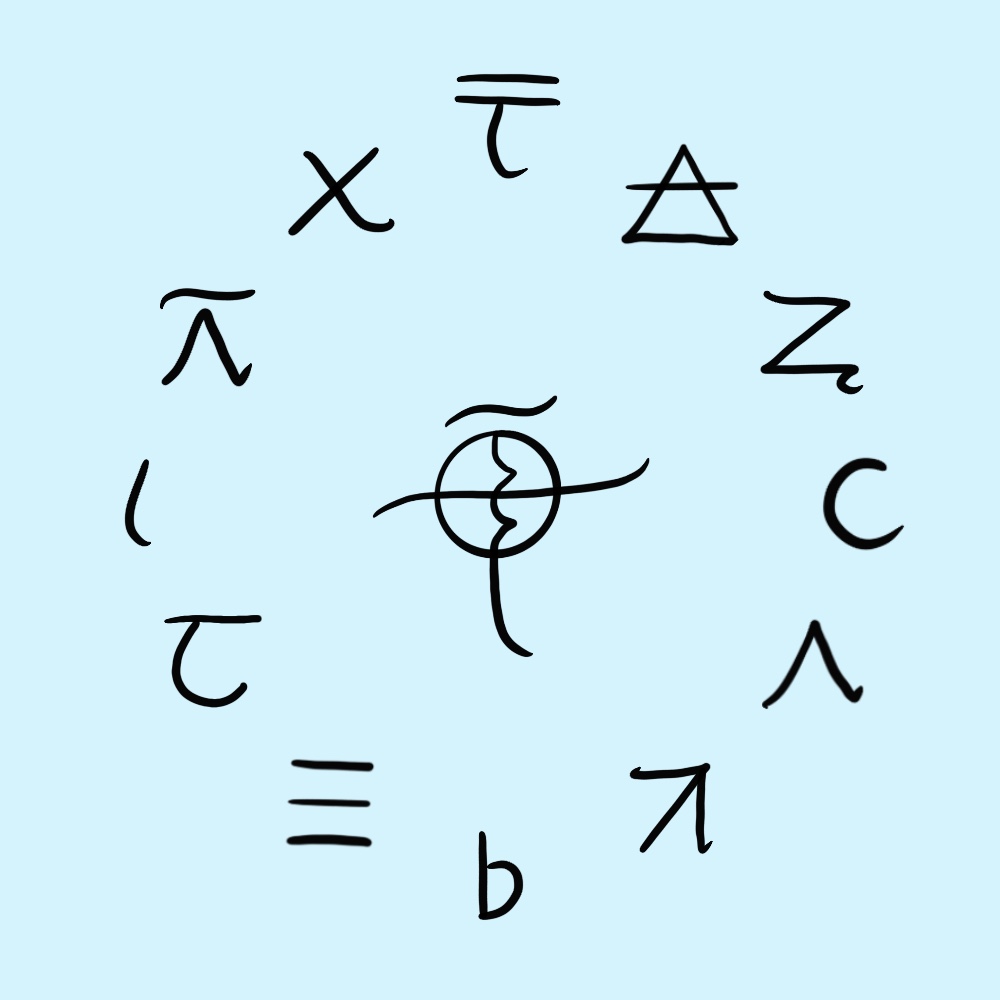
At the centre is a ligature of the letters A, L, Ď, and E, which I am proposing as a symbol for music in general, perhaps as recognisable on Almea as the treble clef is on Earth. It could be referred to as the znak alaďee (‘symbol/letter of music’). Among its functions could be to highlight and disambiguate strings of musical notation from text, since musical notation makes heavy use of letters of the alphabet.
Around the znak alaďee sit the twelve znakî aďië (‘letters of gods’) which symbolise the twelve notes of the Eretaldan octave.
All terminology here just suggestions. I mocked up a lot of different ligatures too to find this one; I’m happy to share the alternatives if anyone wants to see. It must be a medieval invention, as the ligature would need to be taken from different letters if it had been in use since Caďinorian times.
Edit: it could work for Caďinor just without the voicing bar on top, though a medieval origin still sits right with me; it suits the letter forms better, for one.

At the centre is a ligature of the letters A, L, Ď, and E, which I am proposing as a symbol for music in general, perhaps as recognisable on Almea as the treble clef is on Earth. It could be referred to as the znak alaďee (‘symbol/letter of music’). Among its functions could be to highlight and disambiguate strings of musical notation from text, since musical notation makes heavy use of letters of the alphabet.
Around the znak alaďee sit the twelve znakî aďië (‘letters of gods’) which symbolise the twelve notes of the Eretaldan octave.
All terminology here just suggestions. I mocked up a lot of different ligatures too to find this one; I’m happy to share the alternatives if anyone wants to see. It must be a medieval invention, as the ligature would need to be taken from different letters if it had been in use since Caďinorian times.
Edit: it could work for Caďinor just without the voicing bar on top, though a medieval origin still sits right with me; it suits the letter forms better, for one.
Re: Almeomusica
I like the Wheel of Music.
- WeepingElf
- Posts: 1510
- Joined: Sun Jul 15, 2018 12:39 pm
- Location: Braunschweig, Germany
- Contact:
Re: Almeomusica
So do I. But it would be cooler if the note-letters were arranged according to the circle of fifths.
... brought to you by the Weeping Elf
My conlang pages
My conlang pages
Re: Almeomusica
Thanks both! How’s about this?WeepingElf wrote: ↑Thu Feb 08, 2024 7:05 amSo do I. But it would be cooler if the note-letters were arranged according to the circle of fifths.
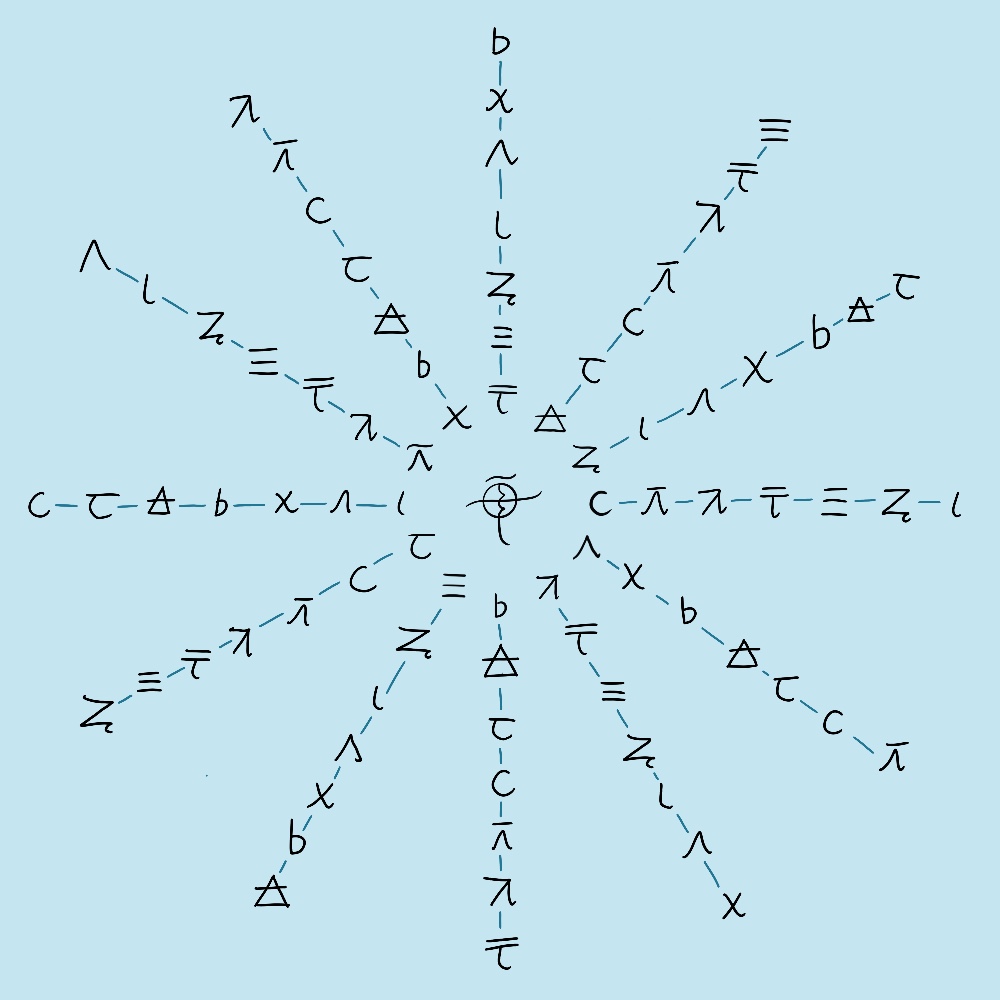
The thing is, the version I drew has a useful role in pedagogy in teaching the equivalence of intervals and contrary intervallic relationships. And I think that the circle of fifths, while absolutely known to Eretaldans and used every day in tuning, and important in its own way compositionally, doesn’t quite have the same preeminent place in musical thought and pedagogy as it occupies in the West (of Earth!).
(I’m happy to say more about this, but also don’t want to over-define it yet… it’s still cooking.)
So what you see now is a companion diagram – the chromatic Siiru Alaďee extended outwards to incorporate the circle of fifths into it.
Thanks to WeepingElf for the good idea!
Note that the perfect fifth is known in Eretaldan parlance as the ‘interval like Enäron-Fidra’, so celoš com efi, or in short form just comefi.
So Siiru Comefië
Ok, this became pretty cool in the end. I like this diagram, if I do say so myself. It’s probably an early modern continuation of the medieval Wheel of Music idea, and is used in the development of cyclic even temperament, whose Almean history I would like to get closer to developing with clarity.
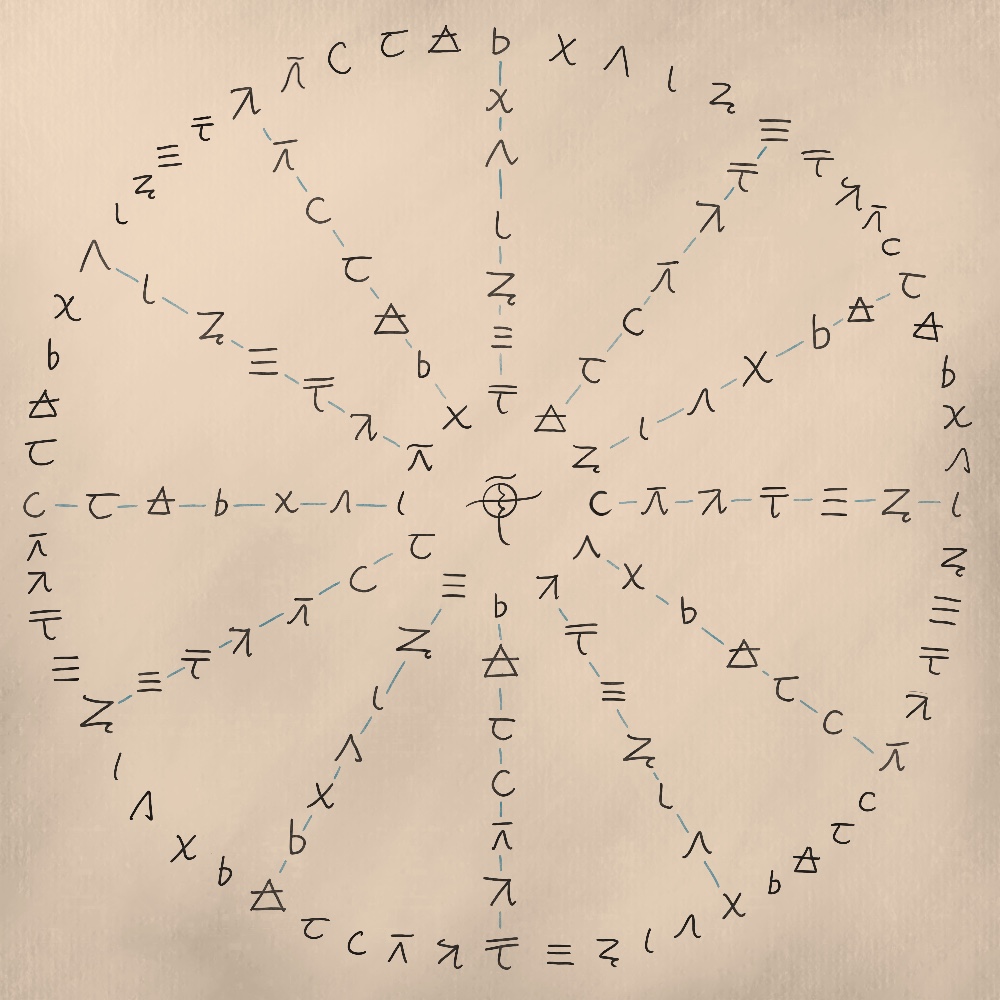

Re: Almeomusica
I don't know enough about either Verdurian or music to understand this, but it sure looks great!
Re: Almeomusica
Thank you, Raphael! I will do something to explain this more fully at some point – it will probably come as part of an article on tuning and temperament in Eretald. Your encouragement is very much appreciated!